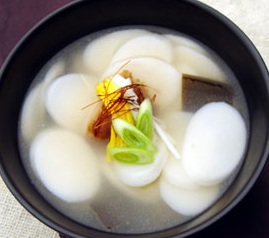Today I will be posting up another Korean recipe, it is soybean paste stew, or Doenjang Jjigae (된장 찌개). It is made using Korean soybean paste and a variety of vegetables, mushrooms seafood or tofu. It is hearty stew that is great to eat in winter when the weather is very cold, much like Seoul at the moment.
The main ingredient of the stew; deonjang, is actually made in an interesting manner. I personally find that it is interesting enough to explain so here goes the explanation.
"To produce doenjang, dried soybeans are boiled and stone-ground into coarse bits. This paste is then formed into blocks, which are called meju (메주). The blocks are then exposed to sunlight or warmth. When so exposed, dried rice plants are attached to the surface of the soybean blocks.
The fermentation process begins at this stage. The Bacillus subtilis bacteria (from the plants) reproduce, consuming soybean protein and water in the meju. The unique smell of the meju is mainly the ammonia produced by the bacteria. One to three months later, depending on the block size, the meju are put into large, opaque pottery jars with brine and left to further ferment, during which time various beneficial bacteria transform the mixture into a further vitamin-enriched substance (similar to the way milk ferments to become yogurt). Liquids and solids are separated after the fermentation process, and the liquid becomes Korean soy sauce (Joseon ganjang; 조선간장). The solid, which is doenjang, is very salty and quite thick, often containing (unlike most miso) some whole, uncrushed soybeans.
While traditional homemade doenjang is made with soybeans and brine only, many factory-made variants of doenjang contain a fair amount of wheat flour just like most factory-made soy sauce does. Some current makers also add fermented, dried, and ground anchovies to accentuate the doenjang's savory flavor."
And that is how deonjang is made. The stew itself is hearty and rich in all the flavours of the soybeans. The dish is actually one of the most popular dishes in Korea, it is readily eaten with dinner and is practically available in all Korean eateries.
I have babbled on for long enough about everything other than deonjang jjigae, so it is about time that I started the actual recipe.
Ingredients
1 1/2 tablespoons of doenjang
150g tofu
1 small or medium size onion
1/2 medium size zucchini or squash
5~7 dried anchovies
1 green onion
2 cloves of garlic (minced)
1 green chili pepper (optional)
1 red chili pepper (optional)
1/4 tablespoon Korean hot red pepper powder red pepper flakes (optional)
1/2 cup of mushrooms (optional)
1/2 small or medium size potato (optional)
3 ~ 4 pieces of dasima(kelp) (optional)
Shrimps or clams (optional, when you want to make seafood doenjang jjigae)
Method
1. Mix doenjang (and gochujang, if you want) with water.
2. Pour into the stew pot and add 3 cups of water. (Depending on how salty and thick you want it to be, you can add less or more water.)
3. Remove the heads and intestines from the dry anchovies and put them in the pot.
4. If you have dasima, add it to the pot.
(*The anchovies and dasima are for broth. Most Koreans remove them a few minutes after the water boils.)
5. Slice the vegetables (onion, zucchini, potato or mushrooms).
6. When the water boils, add the chopped vegetables. Add the shrimps or clams if they are not cooked. If they are already cooked, you can add them with the tofu later.
7. Cut the tofu into chunks and chop the green onion.
8. When the vegetables are cooked, add the tofu and green onion.
9. When the stew boils, add the minced garlic, chopped green and red chili pepper. Boil it a couple of minutes more.
10. Serve the doenjang jjigae when it’s hot.
And that is it. It is a simple dish that requires very little time and effort, but gives you so much in return (a full stomach and a warm and fuzzy feeling on the inside)
That is it for my post today, I don't know when I will have time to post again with school, homework and all that. I will try to keep to posting once every week, but don't count on it. I won't forget to post, hopefully ><
Until next time that I post stay warm, healthy and above all healthy.





